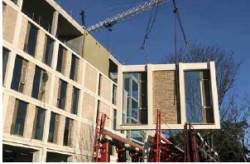In recent years the construction industry has begun to re-evaluate building safety with the hope that we never again witness a tragedy on the same scale as Grenfell Tower, however as MPA UK Concrete explain, the threat of fire in the spaces we live and work remains.
In 2021, the fire and rescue services dealt with 185,437 fires in England alone, tragically including 276 firerelated fatalities. That threat becomes even more significant in multiple occupancy buildings such as flats, hotels, and student accommodations and those with vulnerable occupants including schools, hospitals, and care homes. So how can we ensure that our buildings are designed to protect against fire and give peace of mind to the people that occupy, own and insure them?
The obvious answer – prioritise the use of non-combustible building materials
Building with non-combustible materials means building resilience into the spaces we occupy. While the best protection is always prevention, if a fire does break out, concrete is a reliable material and a low-risk solution that can save lives and property. Concrete is an inherently non-combustible material – it has the highest A1 reaction to fire classification possible (in accordance with BS EN 13501-1:2018).
Conducting routine fire tests on concrete facades isn't necessary to prove that concrete is a noncombustible material or a necessary part of building certification. However, to show how resilient this material can be, MPA Precast carried out a full-scale fire test on precast concrete cladding panels.
Fire test demonstrates superior Performance
It was important that any test or demonstration was carried out by a trusted industry body and in adherence with recognised standards. For this reason, MPA Precast commissioned the Fire Protection Association (FPA) to carry out a BS 8414-2:2020 test. The test method sets out a clear process of assessing the behaviour of non-load bearing external cladding, rainscreen over cladding, and external wall insulation systems exposed to an external fire.
The fire exposure is designed to be representative of an external fire source or a fully developed (postflashover) fire in a room, venting through an opening such as a window aperture that exposes the cladding to the effects of external flames.
During the test period, in which a timber crib within the concrete panels was set alight, temperatures of greater than 600ºC were recorded mid-way up the facade. Despite the ferocity of this fire, internal temperatures barely rose above an ambient level and remained cool enough to touch, showing how effectively concrete can act as a heat shield between the fire and anything behind it.
Once the fire was extinguished, the panels exhibited minor cosmetic damage, but were otherwise structurally sound. If the panels were in use in a building, the work needed to get the building in working order again would be minimal.
Combustible materials introduce risks for owners and occupants
The MPA Precast test shows the advantages of concrete's relatively low thermal conductivity and inherent non-combustibility which enables it to act as a fire shield not only between adjacent spaces but also to protect itself from fire damage.
In almost all cases concrete does not require any additional fire protection. Conversely, once a structure or cladding element made of combustible materials such as timber becomes involved in a fire, it adds significant fuel. This not only increases the chances of the fire spreading but ultimately raises the potential of the building collapsing.
In addition to adding to the fire burden, construction methods such as lightweight Modern Methods of Construction (MMC) solutions create voids formed of combustible materials and the reignition potential of timber structures also creates safety concerns for fire services. In many cases, these factors result in the need for a building to be partly or completely demolished to fully extinguish the fire.
This risk has been recognised by groups including the National Fire Chiefs Council, whose operational guidance highlights some of the hazards present in timber structures – especially those still under construction. The insurance challenges presented by mass timber construction have also been emphasised in a recent report by the RISC Authority. Currently, little emphasis is put on the protection of property itself, with regulations focused only on the safe escape of its occupants. Subsequently, raising questions of whether this is adequate.
According to research, 60-80% of businesses fail within 18 months of a serious fire. This can cause a greater impact on insurers than the damage to the building itself. The loss of personal possessions in a fire and spending time in temporary accommodation also adds significantly to the trauma, with lasting repercussions on mental health. In short, the long-term cost of losing a building to fire can reach a long way beyond its initial aftermath.
Concrete provides 'peace of mind'
Concrete is a reliable material and a low-risk solution that can save lives and properties. The MPA Precast fire test can help to give peace of mind to insurers, owners and occupiers of buildings built with concrete facades, a fact which is especially pertinent in the façade sector given the challenges post-Grenfell.
It is incumbent on both the regulators and the construction sector to design and build with the safest possible materials. The answer is obvious, by using non-combustible materials in construction, industry can create safer, more resilient, and longer-life buildings so that if a fire does occur, the damage and impact on lives is limited.
Full details of the BS 8414 test method are available at: www.thefpa.co.uk/fire-testing
For more information and details of the MPA Precast fire test and the non-combustibility of concrete visit: www.thisisukconcrete.co.uk
Read the full story, go to Offsite Magazine









